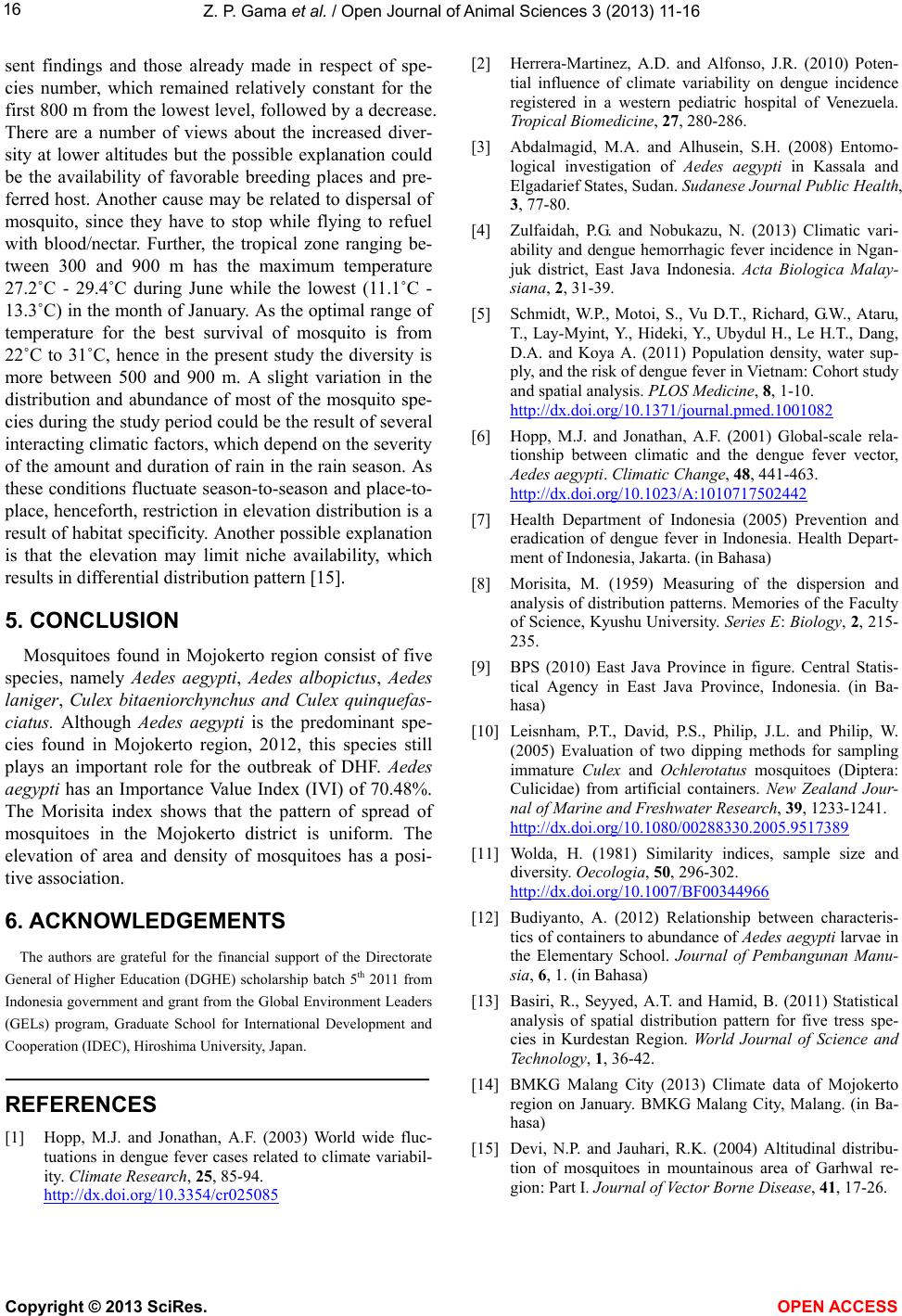
Z. P. Gama et al. / Open Journal of Animal Sciences 3 (2013) 11-16
Copyright © 2013 SciRes.
16
[2] Herrera-Martinez, A.D. and Alfonso, J.R. (2010) Poten-
tial influence of climate variability on dengue incidence
registered in a western pediatric hospital of Venezuela.
Tropical Biomedicine, 27, 280-286.
sent findings and those already made in respect of spe-
cies number, which remained relatively constant for the
first 800 m from the lowest level, followed by a decrease.
There are a number of views about the increased diver-
sity at lower altitudes but the possible explanation could
be the availability of favorable breeding places and pre-
ferred host. Another cause may be related to dispersal of
mosquito, since they have to stop while flying to refuel
with blood/nectar. Further, the tropical zone ranging be-
tween 300 and 900 m has the maximum temperature
27.2˚C - 29.4˚C during June while the lowest (11.1˚C -
13.3˚C) in the month of January. As the optimal range of
temperature for the best survival of mosquito is from
22˚C to 31˚C, hence in the present study the diversity is
more between 500 and 900 m. A slight variation in the
distribution and abundance of most of the mosquito spe-
cies during the study period could be the result of several
interacting climatic factors, which depend on the severity
of the amount an d duration of rain in the rain seaso n. As
these conditions fluctuate season-to-season and place-to-
place, henceforth, restriction in elevation distribution is a
result of habitat specificity. Another possible explanation
is that the elevation may limit niche availability, which
results in differential distribution pattern [15].
[3] Abdalmagid, M.A. and Alhusein, S.H. (2008) Entomo-
logical investigation of Aedes aegypti in Kassala and
Elgadarief States, Sudan. Sudanese Journal Public Health,
3, 77-80.
[4] Zulfaidah, P.G. and Nobukazu, N. (2013) Climatic vari-
ability and dengue hemorrhagic fever incidence in Ngan-
juk district, East Java Indonesia. Acta Biologica Malay-
siana, 2, 31-39.
[5] Schmidt, W.P., Motoi, S., Vu D.T., Richard, G.W., Ataru,
T., Lay-Myint, Y., Hideki, Y., Ubydul H., Le H.T., Dang,
D.A. and Koya A. (2011) Population density, water sup-
ply, and the risk of dengue fever in Vietnam: Cohort study
and spatial analysis. PLOS Medicine, 8, 1-10.
http://dx.doi.org/10.1371/journal.pmed.1001082
[6] Hopp, M.J. and Jonathan, A.F. (2001) Global-scale rela-
tionship between climatic and the dengue fever vector,
Aedes aegypti. Climatic Change, 48, 441-463.
http://dx.doi.org/10.1023/A:1010717502442
[7] Health Department of Indonesia (2005) Prevention and
eradication of dengue fever in Indonesia. Health Depart-
ment of Indonesia, Jakarta. (in Bahasa)
[8] Morisita, M. (1959) Measuring of the dispersion and
analysis of distribution patterns. Memories of the Faculty
of Science, Kyushu University. Series E: Biology, 2, 215-
235.
5. CONCLUSION
Mosquitoes found in Mojokerto region consist of five
species, namely Aedes aegypti, Aedes albopictus, Aedes
laniger, Culex bitaeniorchynchus and Culex quinquefas-
ciatus. Although Aedes aegypti is the predominant spe-
cies found in Mojokerto region, 2012, this species still
plays an important role for the outbreak of DHF. Aedes
aegypti has an Importance Value Index (IVI) of 70.48%.
The Morisita index shows that the pattern of spread of
mosquitoes in the Mojokerto district is uniform. The
elevation of area and density of mosquitoes has a posi-
tive association.
[9] BPS (2010) East Java Province in figure. Central Statis-
tical Agency in East Java Province, Indonesia. (in Ba-
hasa)
[10] Leisnham, P.T., David, P.S., Philip, J.L. and Philip, W.
(2005) Evaluation of two dipping methods for sampling
immature Culex and Ochlerotatus mosquitoes (Diptera:
Culicidae) from artificial containers. New Zealand Jour-
nal of Marine and Freshwater Research, 39, 1233-1241.
http://dx.doi.org/10.1080/00288330.2005.9517389
[11] Wolda, H. (1981) Similarity indices, sample size and
diversity. Oecologia, 50, 296-302.
http://dx.doi.org/10.1007/BF00344966
[12] Budiyanto, A. (2012) Relationship between characteris-
tics of containers to abundance of Aedes aegypti larvae in
the Elementary School. Journal of Pembangunan Manu-
sia, 6, 1. (in Bahasa)
6. ACKNOWLEDGEMENTS
The authors are grateful for the financial support of the Directorate
General of Higher Education (DGHE) scholarship batch 5th 2011 from
Indonesia government and grant from the Global Environment Leaders
(GELs) program, Graduate School for International Development and
Cooperation (IDEC), Hiroshima University, Japan.
[13] Basiri, R., Seyyed, A.T. and Hamid, B. (2011) Statistical
analysis of spatial distribution pattern for five tress spe-
cies in Kurdestan Region. World Journal of Science and
Technology, 1, 36-42.
[14] BMKG Malang City (2013) Climate data of Mojokerto
region on January. BMKG Malang City, Malang. (in Ba-
hasa)
REFERENCES
[1] Hopp, M.J. and Jonathan, A.F. (2003) World wide fluc-
tuations in dengue fever cases related to climate variabil-
ity. Climate Research, 25, 85-94.
http://dx.doi.org/10.3354/cr025085
[15] Devi, N.P. and Jauhari, R.K. (2004) Altitudinal distribu-
tion of mosquitoes in mountainous area of Garhwal re-
gion: Part I. Journal of Vector Borne Disease, 41, 17-26.
OPEN ACCESS